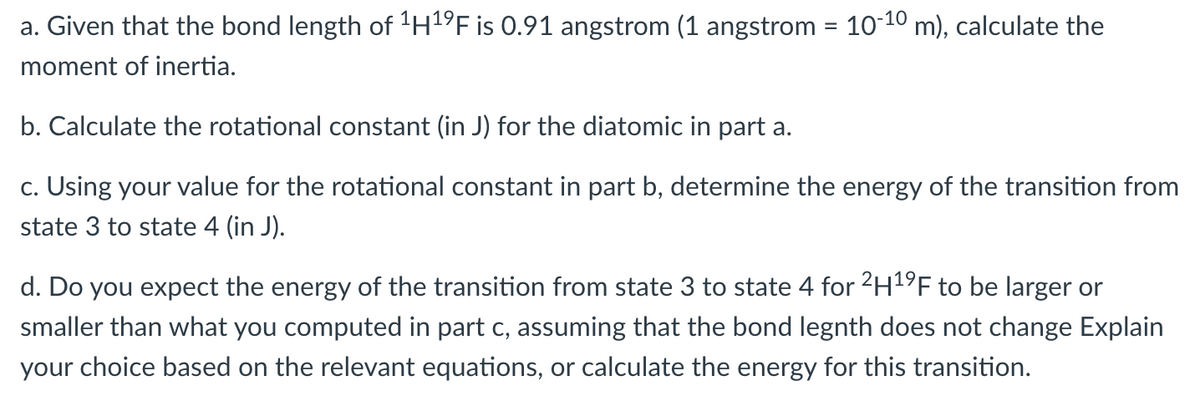a. Given that the bond length of 'H1°F is 0.91 angstrom (1 angstrom = 10-10 m), calculate the %3D moment of inertia. b. Calculate the rotational constant (in J) for the diatomic in part a. c. Using your value for the rotational constant in part b, determine the energy of the transition from state 3 to state 4 (in J).
a. Given that the bond length of 'H1°F is 0.91 angstrom (1 angstrom = 10-10 m), calculate the %3D moment of inertia. b. Calculate the rotational constant (in J) for the diatomic in part a. c. Using your value for the rotational constant in part b, determine the energy of the transition from state 3 to state 4 (in J).
Principles of Modern Chemistry
8th Edition
ISBN:9781305079113
Author:David W. Oxtoby, H. Pat Gillis, Laurie J. Butler
Publisher:David W. Oxtoby, H. Pat Gillis, Laurie J. Butler
Chapter20: Molecular Spectroscopy And Photochemistry
Section: Chapter Questions
Problem 52AP
Related questions
Question

Transcribed Image Text:a. Given that the bond length of 'H1°F is 0.91 angstrom (1 angstrom = 10-10 m), calculate the
moment of inertia.
b. Calculate the rotational constant (in J) for the diatomic in part a.
c. Using your value for the rotational constant in part b, determine the energy of the transition from
state 3 to state 4 (in J).
d. Do you expect the energy of the transition from state 3 to state 4 for 2H1F to be larger or
smaller than what you computed in part c, assuming that the bond legnth does not change Explain
your choice based on the relevant equations, or calculate the energy for this transition.
Expert Solution
This question has been solved!
Explore an expertly crafted, step-by-step solution for a thorough understanding of key concepts.
This is a popular solution!
Trending now
This is a popular solution!
Step by step
Solved in 3 steps with 1 images

Knowledge Booster
Learn more about
Need a deep-dive on the concept behind this application? Look no further. Learn more about this topic, chemistry and related others by exploring similar questions and additional content below.Recommended textbooks for you

Principles of Modern Chemistry
Chemistry
ISBN:
9781305079113
Author:
David W. Oxtoby, H. Pat Gillis, Laurie J. Butler
Publisher:
Cengage Learning

Chemistry for Engineering Students
Chemistry
ISBN:
9781285199023
Author:
Lawrence S. Brown, Tom Holme
Publisher:
Cengage Learning

Principles of Modern Chemistry
Chemistry
ISBN:
9781305079113
Author:
David W. Oxtoby, H. Pat Gillis, Laurie J. Butler
Publisher:
Cengage Learning

Chemistry for Engineering Students
Chemistry
ISBN:
9781285199023
Author:
Lawrence S. Brown, Tom Holme
Publisher:
Cengage Learning